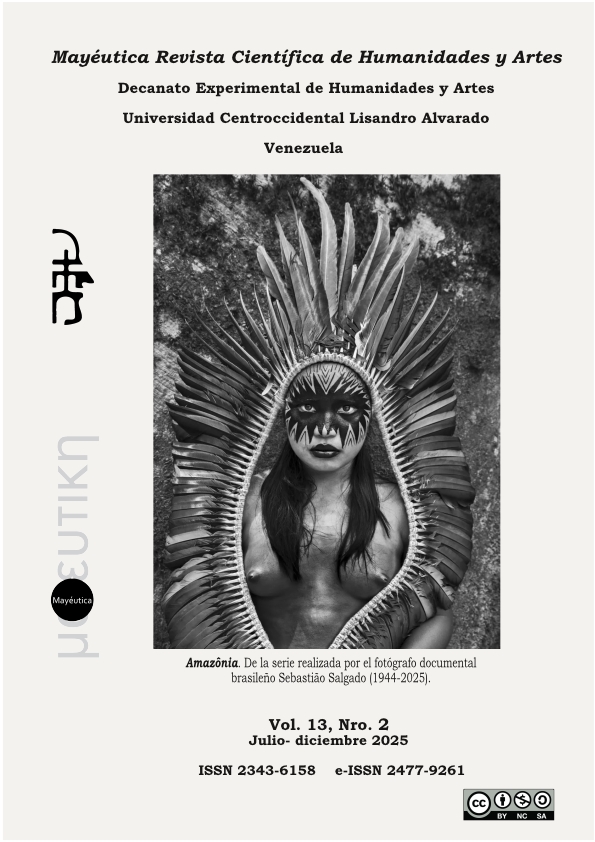In Memoriam Marlos Nobre
DOI:
https://doi.org/10.5281/zenodo.15776007Keywords:
Marlos Nobre, Latin American composers, composers from Brazil, contemporary Latin American musicAbstract
The text pays tribute to the career of Brazilian composer Marlos Nobre (1939-2024), through his contribution to Latin American academic music. Different aspects in which his work stood out, his formation and international consolidation are examined. The syncretism between the avantgarde of the 20th century and traditional Brazilian rhythms is highlighted. An analytical musicological approach is adopted, based on documentary review and critical analysis of Nobre's compositional production. Relevant bibliographical sources are contrasted with the analysis of his music, which was divided into five stylistic periods by the composer. The relationship of his work with the sociocultural context, his influence on Latin American music and his role as a cultural manager are examined. It is shown that Marlos Nobre's work is characterized by the integration of traditional Brazilian rhythms, such as frevo, forró, maracatú, It is expressed that there was a compositional transformation from nationalism to an aesthetic of its own, balanced between the academic and the popular. among others, with avantgarde techniques such as polytonality, atonalism and timbre exploration. It is concluded that Nobre left a work with its own identity, comparable in importance to that of VillaLobos and Ginastera, being an essential reference in the music of the 20th and 21st century.
Downloads
References
Aharonián, C. (1994). Factores de identidad musical latinoamericana tras cinco siglos de conquista, dominación y mestizaje. Revista de Música Latinoamericana, 15 (2), 189-225.http://www.jstor.org/stable/780232
Astor, M. (2008). Los ojos de Sojo: el conflicto entre Nacionalismo y Modernidad en los Festivales de Música de Caracas (1954-1966). [Tesis de doctorado], Universidad Central de Venezuela.
Astor, M. (2012). Armonía para hoy. Unearte.
Astor, M. (2013). Contrapunto para hoy. Unearte.
Barancoski, I. (1997). The interaction of Brazilian national identity and contemporary musical language: the stylistic development in selected piano works by Marlos Nobre. [Tesis de doctorado]. Univerity of Arizona.
Bark, J. M. M. (2006). Marlos Nobre: Concertante do imaginario para piano e orquestra de cordas op. 74: estudo analitico e interpretativo. [Tesis de doctorado]. Universidade Estadual de Campinas. https://repositorio.unicamp.br/acervo/detalhe/388640
Béhague, G. (1994). Heitor VillaLobos: The Search for Brazil’s Musical Souls. Institute of Latin American Studies.
Boulez, P. (1984). Puntos de referencia. Gedisa.
Cage, J. (2013). The Selected Letters of John Cage. Western Univeresity Press.
Cavini, M. P. (2008). As Danzas fascinantes del 4° Ciclo Nordestino para piano de Marlos Nobre: Cabochinhos e Maracatú. Opus, 14 (1), 25-49.https://www.anppom.com.br/revista/ index.php/opus/article/view/234
Corker Nobre, M. L. (1994). Sonancias III, Opus 49 de Marlos Nobre. Latin American Music Review, 15 (2), 226-243.
Freitas, S.G.A. (2009). Marlos Nobre: Sonata para piano sobre tema de Bartók, op. 45. Un abordage analítico desde el fenómeno intertextual. [Tesis de maestría]. Universidad Federal de Río Grande del Sur.
Giraldo Marín, Y.A. (2012). Análisis estructural de “Ut Supra El Fénix” de Blas Emilio Atehortúa. [Tesis de Maestría]. EAFIT.
Gómez, L.E. (2011). Estudio de las formas de apoyo institucional al compositor activo en Venezuela. [Tesis de maestría]. Universidad Simón Bolívar.
Haefeli, A. (1982). IGNM. Die Internationale Gesellschaft für Neue Music. Atlantis Musikbuch.
Júnior, L.A. (2011). Heitor VillaLobos entre o nacionalismo da Mário de Andrade o americanismo de Francisco Curt Lange. Modus. Revista da Escola de Música, 7 (2), 21-35.https://revistas.unibh.br/dchla/article/download/907/908
Koellreuter, H.J. (1947). Música Brasileira. Revista músiva viva, 12.
Kotska, S. (1999). Materials and techniques of twentiethcentury music. PrinticeHall.
Lachenmann, H. (1996). Musik als existentielle Erfahrung: Schriften 1966–1995. Breitkopf & Härtel.
Lachenmann, H. & Rihm, W. (2010). Conversazioni e scritti. Ricordi.
Ferraz, R.G.C. (2007). Ciclos nordestinos 1, 2 y 3 para piano de Marlos Nobre: un abordaje analíticointerpretativo. [Tesis de maestría]. Universidade Federal de Paraíba. https://repositorio.ufpb.br/jspui/handle/tede/6629
Nobre, M. (1967). Insuficiência da notacao convencional em face das novas exigências da música contemporanea. Music in the Americas. Interamerican Music Monograph Series, vol. 1, (pp.148-157).Indiana University Press.
Nobre, M. (1971). Música Brasilera Contemporánea. Revista de Cultura Brasilera, 32.
Nobre, M. (1978). La problemática de la música latinoamericana. Revista Musical Chilena, 32 (142), 125-130.
Ornaghi, M. A. (2013). Nacionalismo e música erudita de vanguarda no Brasil e Argentina: Camargo Guarnieri e Alberto Ginastera (1930 1960). [Tesis de Maestría]. Universidad Estadual Paulista.https://acervodigital.unesp.br/handle/11449/110589
Ortiz Niño, J.M. (2019). Dos piezas para guitarra en el espíritu popular colombiano de Blas Emilio Atehortúa. Descripción interpretartiva con apuntes del compositor. [Tesis de maestría]. EAFIT.
Paraskevaídis, G. (2013). La presencia de compositores argentinos en los Cursos Latinoamericanos de Música Contemporánea. Revista Argentina de Musicología, 14, 53-76.https://ojs.aamusicologia.ar/index.php/ram/article/view/73/79
Porto, N. T. (2002). H.J. Koellreutter e Musica Viva. Catalisadores da música moderna no Brasil. Galáxia, 3,253-259.
Said, E. W. (2010). Música al límite. Tres décadas de ensayos y artículos musicales. Debate.
Salzer, F. (1982). Structural Hearing: Tonal Coherence in Music. Dover Publications.
Sans, J.F. (2021). Edición crítica y composición musical. En Luis PérezValero (ed.). 2° Simposio en composición e investigación musical latinoamericana. (pp.91-140). UArtes Ediciones.
Scarambone, B. (2006). The Piano Works of Marlos Nobre. [Tesis doctoral]. University of Houston.
SchwartzKates, D. (2010). Alberto Ginastera. A Research and Information Guide. Taylor & Francis.
Silva, J.R.T. (2007). Reminiscencias, op. 78 de Marlos Nobre: un estudio técnico e interpretativo. [Tesis de maestría].Universidade Federal de Bahía. https:// repositorio.ufba.br/handle/ri/9166
Simao, L.P. & Schaub, S. (2019). O Maracatu de Marlos Nobre: análise, contextualização e interpretação. En 5° encontro internacional de teoria e análise musical. Universidade Estadual de Campinas, (pp. 134-138).
Strauss, J. (2005). Introduction to PostTonal Theory. Prentice Hall.
Stravinski, I. (2006). Poética musical. Acantilado.
Vázquez, H. G. (Ed.). (2015). Conversaciones en torno al CLAEM: entrevistas a compositores becarios del Centro Latinoamericano de Altos Estudios Musicales del Instituto Torcuato Di Tella. Instituto Nacional de Musicología" Carlos Vega".
White, John D. (1994). Comprehensive musical analysis. The Scarecrow Press
Published
How to Cite
Issue
Section

This work is licensed under a Creative Commons Attribution-NonCommercial-ShareAlike 4.0 International License.





